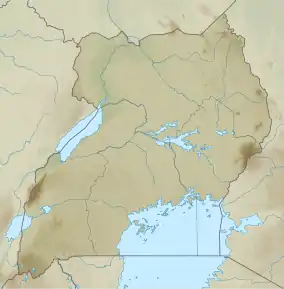Lake Bisina
Lake Bisina, also known as Lake Salisbury, is a freshwater lake in eastern Uganda. It is a satellite lake of Lake Kyoga, which it drains into and the two are to some extend directly connected by papyrus swamps.[3] During the high-water rainy season, Lake Bisina can be up to 6 m (20 ft) deep and it is often directly connected to the smaller Lake Opeta, but during the dry season the two are clearly separated.[1]
| Lake Bisina | |
|---|---|
 Kyoga Lake Complex with the Bisina (right) | |
 Lake Bisina | |
| Coordinates | 1°36′28″N 33°57′43″E |
| Primary inflows | Lake Opeta (via streams and swamps) |
| Primary outflows | Lake Kyoga (via streams and swamps) |
| Basin countries | Uganda |
| Max. depth | 6 m (20 ft) (during high-water season)[1] |
| Settlements | Mbale |
| Official name | Lake Bisina Wetland System |
| Designated | 15 September 2006 |
| Reference no. | 1633[2] |
Conservation and ecology
Lake Bisina is one of Uganda's 33 Important Bird Areas and since 2006 a Ramsar-listed wetland of international importance.[4]
The lake is important for fish, notably several threatened haplochromine cichlids like Haplochromis orthostoma,[5] H. argenteus (appears to have disappeared from its main range in Lake Victoria), H. latifasciatus, H. lividus, H. martini (appears to have disappeared from its main range in Lake Victoria), H. maxillaris, H. nubilus, H. parvidens, H. phytophagus and a number of undescribed species.[6] Although Nile perch was introduced to Lake Bisina in the early 1970s, recent surveys have not detected this species, which has been implicated in the extinctions of many haplochromine ciclids elsewhere.[1] A few tilapia species have also been introduced to Lake Bisina and they are still present, along with the native Singida and Victoria tilapias.[1][6] Other, more widespread fish species found in Lake Bisina include marbled lungfish, and various species of catfish, African tetras and elephantfish.[1]
References
- Mbabazi, D. (2009). "Rapid assessment of the fish biodiversity of the Mburo-Nakivali wetland systems and Opeta-Bisina wetland systems, Uganda". In M.O. Opige; A. Byaruhanga (eds.). Ecological baseline surveys of Lake Bisina, Lake Opeta, Lake Mburo and Nakivali wetlands systems. Kampala, Uganda, Nature Uganda. pp. 75–84.
- "Lake Bisina Wetland System". Ramsar Sites Information Service. Retrieved 25 April 2018.
- Green, J. (2009). "The Kyoga Catchment". In H.J. Dumont (ed.). The Nile. Monographiae Biologicae. 89. Springer Science + Business Media B.V. pp. 205–214. ISBN 978-1-4020-9725-6.
- Ramsar Convention on Wetlands. "The Annotated Ramsar List: Uganda". Archived from the original on 7 January 2013. Retrieved 28 June 2012.
- Froese, Rainer and Pauly, Daniel, eds. (2019). "Haplochromis orthostoma" in FishBase. September 2019 version.
- Wanda, F.; B. Gidudu; S. Wandera; R.S. Copeland; J.P. Cuda; W.A. Overholt (2011). "Herbivory of Hydrilla verticillata by Cichlid Fish in Lake Bisina, Uganda". Journal of East African Natural History. 100 (1&2): 113–121.
